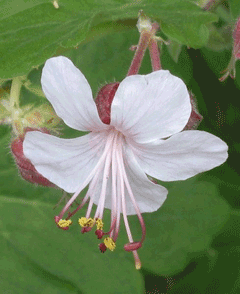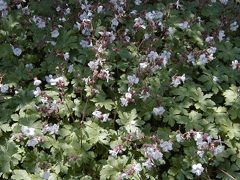 |
|
http://commons.wikimedia.org/wiki/User:Maksim |
 |
| http://commons.wikimedia.org/wiki/User:Cillas |
Translate this page:
Summary
Physical Characteristics

 Geranium macrorrhizum is a PERENNIAL growing to 0.5 m (1ft 8in) by 0.6 m (2ft) at a fast rate.
Geranium macrorrhizum is a PERENNIAL growing to 0.5 m (1ft 8in) by 0.6 m (2ft) at a fast rate.
See above for USDA hardiness. It is hardy to UK zone 4 and is not frost tender. It is in flower from June to August. The species is hermaphrodite (has both male and female organs) and is pollinated by Insects.
Suitable for: light (sandy), medium (loamy) and heavy (clay) soils and prefers well-drained soil. Suitable pH: neutral and basic (mildly alkaline) soils and can grow in very alkaline soils.
It can grow in full shade (deep woodland) semi-shade (light woodland) or no shade. It prefers dry or moist soil and can tolerate drought.
UK Hardiness Map
US Hardiness Map
Synonyms
Plant Habitats
Woodland Garden Dappled Shade; Shady Edge; not Deep Shade; Ground Cover;
Edible Uses
References More on Edible Uses
Medicinal Uses
Plants For A Future can not take any responsibility for any adverse effects from the use of plants. Always seek advice from a professional before using a plant medicinally.
Aphrodisiac
Aphrodisiac[61].
References More on Medicinal Uses
The Bookshop: Edible Plant Books
Our Latest books on Perennial Plants For Food Forests and Permaculture Gardens in paperback or digital formats.

Edible Tropical Plants
Food Forest Plants for Hotter Conditions: 250+ Plants For Tropical Food Forests & Permaculture Gardens.
More

Edible Temperate Plants
Plants for Your Food Forest: 500 Plants for Temperate Food Forests & Permaculture Gardens.
More

More Books
PFAF have eight books available in paperback and digital formats. Browse the shop for more information.
Shop Now
Other Uses
Essential Pot-pourri
The very aromatic leaves have been used in the past as a source of geranium oil[187]. They are used in pot-pourri and perfumery[244]. A good dense ground cover plant[197, 200]. A very effective weed smotherer[187, 190]. Plants grow rampantly, rooting as they spread[208]. They should be spaced about 60cm apart each way[208].
Special Uses
Food Forest Ground cover Scented Plants
References More on Other Uses
Cultivation details
Easily grown in dry or moist situations, in sun or light shade[187, 200]. Succeeds even in deep shade[208]. Tolerates a wide range of soil types, succeeding in any moderately fertile retentive soil[200]. Calcicole[50]. Established plants are drought resistant[190]. A very ornamental plant, there are many named varieties[187]. Members of this genus are rarely if ever troubled by browsing deer or rabbits[233].
References Carbon Farming Information and Carbon Sequestration Information
Temperature Converter
Type a value in the Celsius field to convert the value to Fahrenheit:
Fahrenheit:
The PFAF Bookshop
Plants For A Future have a number of books available in paperback and digital form. Book titles include Edible Plants, Edible Perennials, Edible Trees,Edible Shrubs, Woodland Gardening, and Temperate Food Forest Plants. Our new book is Food Forest Plants For Hotter Conditions (Tropical and Sub-Tropical).
Shop Now
Plant Propagation
Seed - sow spring in a cold frame. When they are large enough to handle, prick the seedlings out into individual pots and plant them out in the summer. Division in spring or autumn. Very easy, virtually every bit of a divided plant, whether it has roots or not, will grow away and produce roots[190]. Larger clumps can be replanted direct into their permanent positions, though it is best to pot up smaller clumps and grow them on in a cold frame until they are rooting well. Plant them out in the spring.
Other Names
If available other names are mentioned here
Native Range
EUROPE: Austria, Albania, Bulgaria, Greece, Croatia, Italy, Romania, Serbia, Slovenia, France
Weed Potential
Right plant wrong place. We are currently updating this section.
Please note that a plant may be invasive in one area but may not in your area so it's worth checking.
Conservation Status
IUCN Red List of Threatened Plants Status :

| Related Plants
|
| Latin Name | Common Name | Habit | Height | Hardiness | Growth | Soil | Shade | Moisture | Edible | Medicinal | Other |
| Bauhinia purpurea | Orchid Tree, Purple Butterfly Tree, Mountain Ebony, Geranium Tree, Purple Bauhinia | Tree | 10.0 |
9-12
| F | LM | SN | M | 2 | 2 | 4 |
| Geranium bicknellii | Bicknell's cranesbill | Annual/Biennial | 0.6 |
0-0
| | LMH | N | M | 1 | 1 | |
| Geranium dissectum | Cut-Leafed Cranesbill, Cutleaf geranium | Annual | 0.6 |
6-9
| | LMH | N | M | 1 | 2 | 2 |
| Geranium erianthum | Wooly Geranium | Perennial | 0.3 |
3-7
| | LMH | SN | M | 1 | 1 | |
| Geranium incanum | Geranium, Cranesbill | Perennial | 0.4 |
4-9
| F | LMH | N | M | 1 | 0 | |
| Geranium lucidum | Shining geranium | Annual | 0.5 |
6-9
| | LMH | N | DM | 0 | 1 | 2 |
| Geranium maculatum | Spotted Cranesbill, Spotted geranium, Crowfoot, Wild Geranium, Cranesbill | Perennial | 0.6 |
3-10
| M | LMH | N | MWe | 0 | 3 | 2 |
| Geranium molle | Dovefoot Geranium | Annual | 0.4 |
-
| | LMH | N | DM | 0 | 1 | |
| Geranium nepalense | Nepalese Crane's Bill | Perennial | 1.0 |
6-9
| | LMH | N | M | 1 | 2 | 1 |
| Geranium ocellatum | | Annual | 0.3 |
-
| | LMH | N | M | 0 | 1 | |
| Geranium pilosum | | Perennial | 0.3 |
-
| | LMH | N | M | 1 | 0 | |
| Geranium potentilloides | Native Carrot, Cinquefoil geranium | Perennial | 0.6 |
0-0
| | LMH | N | M | 1 | 0 | |
| Geranium pratense | Meadow Crane's Bill, Meadow geranium, Geranium | Perennial | 1.2 |
5-9
| F | LMH | N | M | 0 | 2 | |
| Geranium pusillum | Small geranium | Perennial | 1.0 |
6-9
| | LMH | N | DM | 0 | 1 | |
| Geranium robertianum | Herb Robert, Robert geranium | Annual/Biennial | 0.4 |
5-9
| | LMH | SN | DM | 0 | 2 | 2 |
| Geranium rotundifolium | Roundleaf geranium | Annual | 0.4 |
6-9
| | LMH | N | M | 0 | 1 | |
| Geranium sibiricum | Siberian geranium | Perennial | 0.2 |
5-9
| | LMH | N | M | 0 | 1 | |
| Geranium solanderi | Solander's Geranium | Perennial | 0.6 |
-
| | LMH | N | M | 1 | 0 | |
| Geranium sylvaticum | Wood Cranesbill, Woodland geranium | Perennial | 1.0 |
4-8
| | LMH | FSN | M | 0 | 0 | 3 |
| Geranium thunbergii | Thunberg's geranium | Perennial | 0.3 |
6-9
| | LMH | N | M | 1 | 1 | |
| Geranium tuberosum | | Perennial | 0.3 |
7-10
| | LMH | N | M | 2 | 0 | |
| Geranium viscosissimum | Sticky Geranium, Sticky purple geranium | Perennial | 0.8 |
6-9
| | LMH | SN | M | 1 | 2 | |
| Geranium wallichianum | | Perennial | 0.3 |
6-9
| | LMH | SN | M | 0 | 2 | 3 |
| Geranium wilfordii | | Perennial | 0.6 |
-
| | LMH | SN | M | 0 | 2 | |
| Heuchera americana | Rock Geranium, American alumroot, Alumroot, Coral Bells, Rock Geranium | Perennial | 0.5 |
4-9
| M | LM | SN | M | 0 | 3 | 2 |
| Pelargonium australe | Ivy Geranium | Perennial | 0.3 |
8-11
| | LM | N | DM | 1 | 1 | |
| Pelargonium capitatum | Rose-Scented Geranium | Shrub | 0.6 |
8-11
| | LM | N | DM | 0 | 3 | 3 |
| Pelargonium crispum | Lemon Geranium | Shrub | 0.7 |
8-11
| | LM | SN | DM | 2 | 2 | 3 |
| Pelargonium exstipulatum | Pennyroyal Geranium | Shrub | 1.0 |
8-11
| | LM | N | DM | 1 | 2 | 2 |
|
|
Growth: S = slow M = medium F = fast. Soil: L = light (sandy) M = medium H = heavy (clay). pH: A = acid N = neutral B = basic (alkaline). Shade: F = full shade S = semi-shade N = no shade. Moisture: D = dry M = Moist We = wet Wa = water.
Now available:
Food Forest Plants for Mediterranean Conditions
350+ Perennial Plants For Mediterranean and Drier Food Forests and Permaculture Gardens.
[Paperback and eBook]
This is the third in Plants For A Future's series of plant guides for food forests tailored to
specific climate zones. Following volumes on temperate and tropical ecosystems, this book focuses
on species suited to Mediterranean conditions—regions with hot, dry summers and cool, wet winters,
often facing the added challenge of climate change.
Read More
Expert comment
Author
L.
Botanical References
1750200
Links / References
For a list of references used on this page please go here
Readers comment
| Add a comment |
|
If you have important information about this plant that may help other users please add a comment or link below. Only comments or links that are felt to be directly relevant to a plant will be included. If you think a comment/link or information contained on this page is inaccurate or misleading we would welcome your feedback at [email protected]. If you have questions about a plant please use the Forum on this website as we do not have the resources to answer questions ourselves.
* Please note: the comments by website users are not necessarily those held by PFAF and may give misleading or inaccurate information.
To leave a comment please Register or login here All comments need to be approved so will not appear immediately.
|
Subject : Geranium macrorrhizum
|
|
|
|